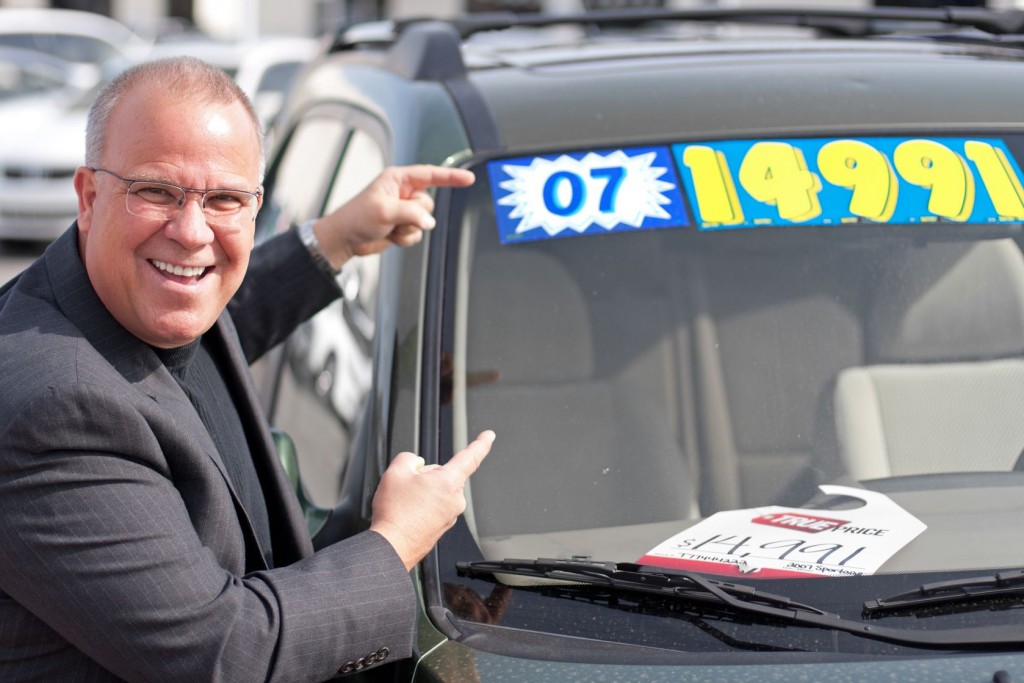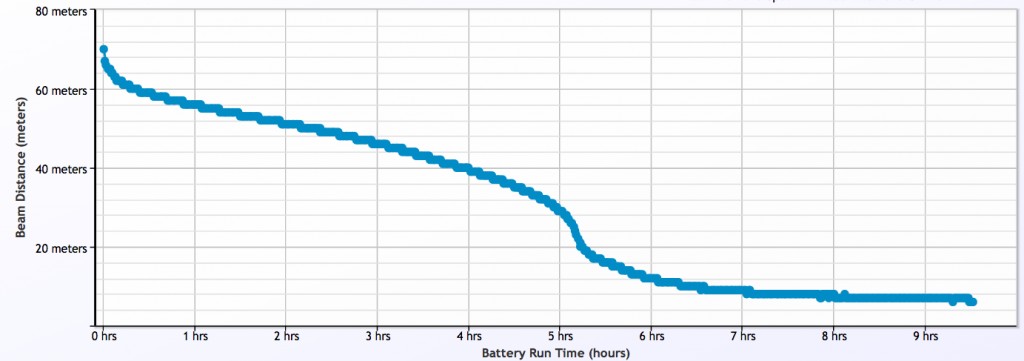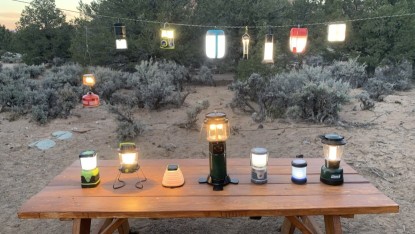Not all the specs on headlamp packaging are a straight-out lie, but after extensively testing more than 100 headlamps over the last seven years we feel confident declaring the combination of maximum beam distance and battery run-time to be both misleading and deceptive in many cases. We'll try to pick this issue apart to help you navigate headlamp specs wisely and know what claims to view with skepticism.
― H.G. Wells
Beam Distance is Overstated
In our tests, we found that most manufacturers overstated beam distance relative to what we measured. The difference was not huge — about nine percent on average — but even if they were the same, the beam distance specs are only valid in the initial minutes of use with a fresh battery.
So, here's what you need to know about beam distance claims:- Beam distance degrades rapidly with battery life.
In most of the lights we tested, the beam distance degrades by more than 30 percent after only a few hours of use. Because the maximum beam distance measurements are taken with fresh batteries, after only being turned on for about a minute, these distance claims will inevitably overstate your actual experience with sustained use in the field.
Battery Run-time — the Big Lie
The most deceptive specification is the battery life. Technically the battery life figure is not a lie, but rather a deceptive marketing trick in how it is measured that we consider misleading. Let us break it down for you.
By citing battery life and beam distance side-by-side, most consumers assume a linkage.
If the package says the high output mode of a light shines a 70 meter beam and a battery run-time of 50 hours, most reasonable people think it means, "with this one I can see 70 meters for 50 hours."
But in fact, those beam distance and battery life figures don't go together, at all.
As we mentioned above, beam distance degrades very rapidly as batteries drain. Much more rapidly than most people would guess. The Black Diamond Spot is rated by the manufacturer at 75 meters and a 50 hour battery run-time, but in our tests we found beam distance degrades from an initial 70 meters to less than 10 meters within seven hours.
We believe that some manufacturers game the specs by designing their lights to initially produce a very bright light (thus earning a long beam distance spec), even though it degrades very rapidly. Then, to game battery run-time, they design their lights to produce a long-tail of dim light, reserving the last stage of battery life to produce long period of dim survival light which may be barely brighter than a candle placed two meters away, to justify their battery run-time.
The question we pose for manufacturers is whether they think consumers understand that their very long battery run-time claims are based primarily on this very, very, dim light.
The ANSI FL-1 Spec
It wasn't supposed to work out this way. In 2009 a group of manufacturers of headlamps and flashlights, along with other participants such as REI, got together to develop a voluntary testing and specification standard. That working group published the 2009 ANSI FL1 Flashlight basic performance standard. The idea of that document was to create a standard for flashlight and headlamp specs that would make it easier for consumers to understand performance. (For a mere $68 you can download the complete FL-1 spec from the ANSI website in a copy-protected PDF.)
The ANSI FL-1 spec made a reasonable decision on battery run-time: once the brightness diminished below 10 percent of its fresh battery value, you stop the clock on run-time.
Some people might argue that waiting until 90 percent of the brightness is diminished is too lax a standard for battery run-time. After all, if you are saying the run-time specification is for the high-output mode, shouldn't the brightness be, well, high-output? Is it fair to say that 10 percent of the maximum is still high output?
Our view on this is that the ANSI FL-1 standard for run-time seems pretty reasonable. Any standard must make a decision on when to stop the clock, and having looked at the brightness level when a light reaches the 10 percent cut-off, we think it is a reasonable point to stop the clock. To that end, we used the same definition in our own measurements of battery run-time.
But, here's the rub.
The headlamp manufacturers don't use the ANSI FL-1 standard for battery run-time, even though they helped create the FL-1 spec in 2009 and rely on it as the guiding standard for every other major specification they use in their marketing claims (e.g. beam distance, water resistance, lumens, etc).
Headlamp Manufacturer's Abandon ANSIThe headlamp manufacturers decided they didn't like that ANSI definition of battery run-time.
So, the headlamp manufacturers made up their own battery run-time standard that is vastly more lenient. In fact, it is so lenient that we consider to be deceptive.
How does this happen?
Clearly there was a difference of opinion between the product engineers who likely developed the ANSI FL-1 standard and the management at the manufacturers' headquarters. It is pretty typical to send a technical engineer to something like an ANSI standards committee meeting, and we assume it was a room filled with flashlight and headlamp nerds who came up with what we feel is a pretty reasonable ANSI FL-1 spec.
Those same headlamp engineers probably returned to their respective company headquarters and performed tests to see what the new ANSI standard would mean in terms of future product specifications on packaging. On average, our measurements of battery run-time using the ANSI standard are a fourth of the manufacturer's claims, and in some cases the manufacturer's claimed run-time is more than 10 times overstated relative to our ANSI FL-1 run-time measurements. For example, the Princeton Tec Vizz has a claimed run-time of 110 hours but our tests showed it having only 3.2 hours based on the ANSI Fl-1 spec. Similarly, the Black Diamond Spot has a claimed run-time of 50 hours, yet we measured it at 5.2 hours. The popular Petzl Tikka XP2 has a claimed run-time of 70 hours, yet we measured it at only 5.8 hours. In all three cases, the manufacturer's claimed run-time is over 10 times overstated based on our ANSI FL-1 measurements. For these manufacturers to change the marketing claims to reflect the ANSI standard would mean admitting to consumers that they had been wildly exaggerating for years. At some point, the run-time tests results would have made their way to the marketing departments. And, that is probably about the time the sh#t hit the fan.
Why? Because headlamp manufacturers are reluctant to admit they have been blowing smoke on battery run-time for years, and the ANSI FL-1 standard would mean an end to outrageous claims like 110-hour run-time on a light that produces less than four hours based on the ANSI FL-1 spec. From our point of view, fully embracing the ANSI FL-1 spec would be a great thing for the industry, and mean that product specs would more accurately reflect the real-world performance consumers experience.
But, it seems that someone at the headlamp manufacturers decided that going from years of claiming deceptive battery run-times, to a figure that is more realistic, was just too much crow to eat.
In the end, it appears a consensus was built among manufacturers to return to their prior method of calculating battery run-time, and much to our dismay REI, who we would think of as the responsible adult in the room, appears to have gone along with it.
The way manufacturers are now measuring battery run-time is based on a dubious definition of "usable" light. In their standard, the battery run-time clock continues for their high-output mode so long as the brightness exceeds the very dim level of a candle placed two meters away (0.25 lux). In some cases, this means the clock is still running when the light is less than 0.1 percent of the brightness used as a basis for the corresponding beam distance claims.
The "Moonlight" StandardThe manufacturers frame their definition of usable light under the so-called "moonlight" standard, which we also think is misleading. REI (who we love) seems to be drinking the kool aid here, too:
We're sorry, but we have to call bullsh#t here.
Hiking under full moon light is nothing like hiking with a headlight that registers 0.25 lux from two meters away.
We've spent many pleasant evenings hiking under the full moon, and perhaps more to the point, we've also spent a lot of time hands-on testing lights at the very dim 0.25 lux level. We know how dim a light producing 0.25 lux at two meters really is. And, from that experience we can tell you that hiking with a light producing 0.25 lux is not even close to hiking under a full moon. The reason is simple and obvious if you try it.
On a clear night, under a full moon, if you place a light meter on the ground in front of you it will measure about 0.25 lux (you'll get a higher lux reading at high elevations near the equator, but let's ignore that). If you move that light meter 10 meters away from you, it will also show 0.25 lux. In fact, everywhere you place that meter, even a mile away, will register 0.25 lux. That light level is bright enough that you can see a long distance, and at least as importantly you can see topography, trees, mountains and the trail ahead for a long distance.
Not so with a headlamp that produces 0.25 lux when measured at two meters distance from the source.
The brightness level from a single source light degrades with the square of distance. So, while the brightness of moonlight is no different as far as you can see, given that the moon as a source is still about the same 289,000 miles away anywhere you look, not so the brightness from your headlamp, which gets dimmer rapidly by distance. If you set your light meter on trail about four steps ahead, about four meters from the dim light on your head, it will now only show 25 percent of the full moon brightness (0.06 lux), which pretty much everyone in the lighting industry agrees is not a "usable" level of light. If you move the light meter 10 meters away, it is 25x dimmer than moonlight or 0.01 lux. If you try to look 20 meters ahead, the light is now 100x dimmer than moonlight. This is a completely different experience than hiking under a full moon. Walking around with a light that produces 0.25 lux at two meters on a moonless (or cloudy) night is completely unlike walking under full moonlight.
The "Candlelight" Standard Would Be a Better Name
There is another, much more accurate standard, that the industry could use to describe 0.25 lux: candlelight. It turns out that a candle, placed two meters away, also produces about 0.25 lux. But, unlike moonlight that would still register 0.25 lux a 100-meter distance away, the candlelight brightness is quite useless beyond a few meters. No one hiking with by single candle on a moonless night would consider it anything like hiking under a full moon. It is not a "usable" light level for outdoor hiking.
The problem here is one of consumer deception.
Let us show you graphically what this means in practice.
The beam image on the left has a brightness of 660 lux, and the image in the middle is at the ANSI standard of 10 percent of the initial brightness, or about 66 lux (both measured at two meters). The image on the right is 10 lux, or 1.5 percent of initial brightness shown at left (but still 40x brighter than candlelight). The ANSI standard would say that high-output run-time is over once the beam at left degrades to 10% level shown in the middle image. That seems reasonable to us. But, the manufacturers standard would allow light levels much dimmer than the image on the right to qualify for "high output" in their battery run-time specification.The manufacturers' spec is so lenient that it opens the door to gaming the system by designing lights that run for a little while at full output, and then downshift to a dim light survival mode that will give them unbelievably long-battery life run-time specs, even though their effective battery life under the ANSI standard is much, much, shorter. The example below shows just that kind of situation.
Are Battery Run-time Claims Deceptive?
It's against the law in the U.S. to make claims in advertising and packaging that are deceptive or misleading to consumers. The Federal Trade Commission (FTC) describes those standards in their publication FTC's Section 5: Unfair or Deceptive Acts or Practices (pdf) guidelines.
The FTC Section 5 publication defines the three criteria of a deceptive act or practice as:- A representation, omission, or practice misleads or is likely to mislead the consumer
- A consumer's interpretation of the representation, omission, or practice is considered reasonable under the circumstances; and
- The misleading representation, omission, or practice is material.
We think the battery run-time specs meet all three criteria, and thus should be considered a deceptive representation in violation of Federal Trade law.
It is our firm opinion that most consumers are misled by headlamp specs to believe that beam distance and run-time specs are meant to go together, and thus interpret a specification to mean "shines a beam 70 meters distance for 50 hours." There is no fine print we've seen that discloses or clarifies to consumers what these specs really mean.
We think no reasonable consumer would expect the actual 5.2 hours performance as shown below from the advertising representation of run-time.
We ask you to help us lobby manufacturers and retailers, in particular, REI which participated in the development of the ANSI FL-1 specification, and is thus the most likely retailer to help get battery run-time claims to comply with the reasonable FL-1 standard for battery run-time measurement. With your help, we can make headlamp marketing claims more realistic and helpful to all consumers.
If you are a member of REI, please take a moment to write REI's CEO, Jerry Stritzke, to express your concerns about REI's complicity in deceptive headlamp battery run-time marketing claims at this address:
Jerry Stritzke, CEORecreational Equipment, Inc.
6750 S. 228th St.
Kent, Washington 98032
Or, use REI's email feedback form to express your concerns.
You can read our letter to the CEO of REI here (pdf).
Please note that we have great respect for REI, and it is not our intention to tarnish their reputation in any way. Quite the opposite. Given REI's extraordinary commitment to customer service as demonstrated by 100% Satisfaction Guarantee and their commitment to stewardship, we see them as a powerful advocate for their members' interests. We believe that REI is very likely to respond quickly to concerns from their membership about deceptive headlamp marketing claims. As the industry's leading retailer, they have the muscle to make sure their members are treated fairly by manufacturers and force reconsideration of whether we'd all be better off if headlamp manufacturers complied with the ANSI FL-1 standard for battery run-time claims.
Thanks for your help in making a difference.
The Editors of OutdoorGearLab













